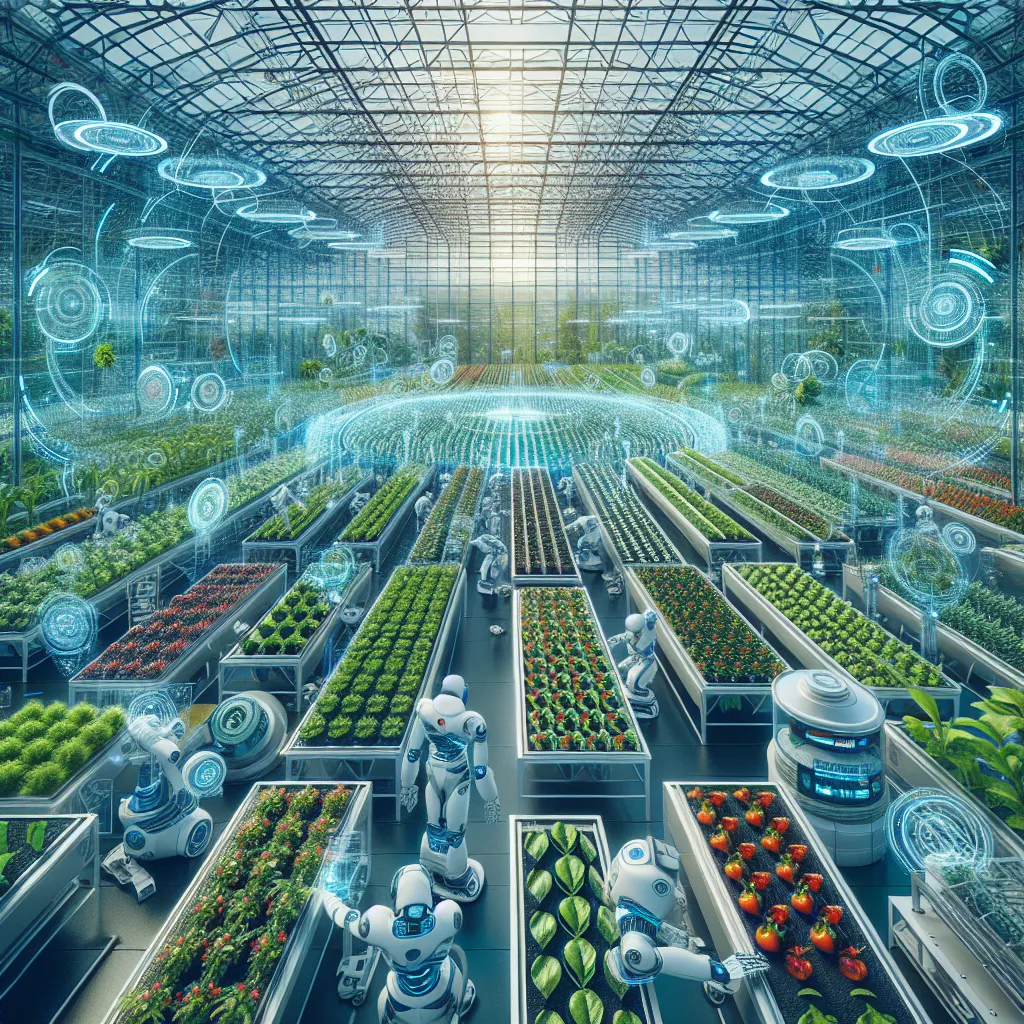The article discusses the advancements in nanotechnology for air purification in urban environments, highlighting the potential of nanomaterials such as titanium dioxide and carbon nanotubes in capturing and degrading air pollutants at the molecular level. It also explores the role of AI and machine learning in improving urban air quality, emphasizing their contribution to real-time monitoring of air pollutants and the development of targeted solutions. Additionally, the article delves into sustainable solutions, focusing on the use of renewable energy, particularly solar-powered air purification systems, to address urban air pollution. Overall, the article presents a comprehensive overview of cutting-edge technologies and their potential impact on creating sustainable and healthier urban environments, making it a compelling read for those interested in the intersection of technology and environmental sustainability.
The Future of Food Supplies: Challenges and Opportunities
The article “Feeding the World: The Future of Food Supplies” delves into the complexities and challenges of meeting the global population’s increasing food demands. It highlights the impact of climate change on agricultural productivity, emphasizing the necessity of climate-resilient agriculture and the development of drought-tolerant crops. Additionally, the article underlines the critical need for sustainable practices to conserve natural resources and mitigate environmental degradation. Furthermore, it discusses opportunities for revolutionizing food supplies through technological advancements, such as biotechnology, genetic engineering, vertical farming, and aquaponics. The article ultimately advocates for a multi-faceted approach that integrates sustainable practices, technological innovations, and international collaboration to ensure a future where everyone has access to ample and nutritious food supplies. It presents a compelling and comprehensive outlook on the future of food supplies, urging readers to consider the intricate balance between meeting rising food demands and preserving the environment.
Exploring the Rise of Plant-Based Diets in the Food Industry
The article “The Evolution of Plant-Based Diets in Nutrition” explores the growing trend towards plant-based diets, driven by factors such as health awareness, sustainability, and ethical considerations. It discusses how plant-based diets have evolved to meet the nutritional needs of the average individual, offering a wide array of essential nutrients and flavorful options. Scientific research supporting the health benefits of plant-based diets, such as reducing the risk of chronic diseases and improving overall mortality rates, further emphasizes their role in promoting long-term well-being. Moreover, the impact of plant-based diets on the food industry is highlighted, with the transformation of the food market and the reshaping of the retail landscape to accommodate the increasing demand for plant-based products. The article presents a compelling case for the significance of plant-based nutrition in shaping the future of food consumption, emphasizing their diverse benefits for both individuals and the planet.
The Importance of Shelter in Human Life
The article emphasizes the vital role of shelter in human survival, highlighting its significance in providing protection from the elements, a sense of security, and a space for rest and recuperation. It underlines how shelter has historically shaped human civilizations and continues to be crucial for public health and well-being in modern society, with homelessness and inadequate housing posing significant challenges. Furthermore, it discusses the psychological impact of adequate housing, emphasizing how secure and stable living environments are fundamental for individual and collective well-being. The article’s comprehensive approach to the topic encourages readers to recognize the profound influence of shelter on human experiences and psychological health, ultimately advocating for efforts to ensure access to safe, affordable housing for all.
Optimizing Office Supplies Management: Strategies for Efficiency
This article discusses the benefits of implementing cloud-based inventory systems, sustainable procurement practices, and leveraging data analytics for optimizing office supplies management. It emphasizes how cloud-based systems offer real-time visibility, flexibility, and advanced analytics for better forecasting and cost-effective inventory management. Furthermore, it highlights the importance of sustainable procurement practices in reducing waste, minimizing environmental impact, and achieving long-term cost savings. Lastly, it emphasizes how leveraging data analytics can provide valuable insights into consumption patterns and inventory levels, enabling organizations to make informed decisions and forecast supply needs more accurately. The article overall showcases the significance of these strategies in achieving greater efficiency, cost-effectiveness, and sustainability in office supplies management, making it a compelling read for businesses looking to improve their processes.
Ensuring Food Security in Times of Crisis: Challenges and Solutions
The article “Understanding the Impact of Global Crises on Food Security” emphasizes the critical importance of comprehending the effects of global crises on food security and their disproportionate impact on vulnerable populations. It discusses the ways in which global crises disrupt the food supply chain and emphasizes the need for resilience-building strategies such as sustainable agricultural practices, improved distribution networks, and support for local food production. The article underscores the potential for proactive measures to enhance food security and resilience in the face of adversity. Meanwhile, “Implementing Resilient Solutions for Ensuring Food Access During Crisis” stresses the significance of resilient solutions for ensuring food access during crises, particularly in the face of disrupted supply chains and price fluctuations. It highlights the need to diversify food production sources, invest in technology and innovation, and promote collaboration between various stakeholders to address vulnerabilities in food systems during crises. These articles provide a comprehensive overview encouraging readers to delve deeper into the full content for actionable insights on addressing food security challenges in times of uncertainty.
The Impact of Foreign Aid on Developing Countries
The article explores the effectiveness of foreign aid in alleviating poverty in developing nations. It highlights both the potential benefits, such as providing essential resources and supporting economic growth, and the challenges, including corruption and dependency. The call to action emphasizes the importance of prioritizing transparency, accountability, and local ownership in aid programs to enhance effectiveness. Additionally, the role of foreign aid in empowering communities and enabling them to drive their own development initiatives is underscored, particularly through capacity building, support for local governance, and civil society organizations. The article provides a comprehensive analysis of the complexities and opportunities associated with foreign aid, ultimately advocating for a more inclusive and participatory approach to maximize its impact on poverty alleviation and sustainable development.
Exploring the Undefined: A Journey into the World of Uncategorized
The article delves into the alluring appeal of unexplored territories, urging curious minds to venture beyond the known. It emphasizes the exhilarating journey of exploring the undefined, breaking free from conventional knowledge, and embracing the mysteries that lie ahead. The free walking tours in Krakow are highlighted as an ideal opportunity to delve into the undefined, offering a unique and immersive experience guided by local experts. The article concludes by emphasizing the transformative nature of embracing the unknown and the endless pursuit of knowledge and understanding. It encourages readers to embark on the captivating voyage into unexplored territories for a truly unforgettable experience.
The Impact of Innovative Gear Designs on Industrial Efficiency
The article “Revolutionizing Industrial Efficiency: The Role of Innovative Gear Designs” highlights the transformative impact of advanced gear technologies on industrial operations. It emphasizes how innovative gear designs have optimized energy utilization, streamlined production processes, and enhanced equipment reliability, ultimately propelling the industrial sector into a new era of performance and sustainability. From cost savings to environmental stewardship and increased competitiveness, the article underscores the pivotal role of innovative gear designs in reshaping industrial efficiency, making it a compelling read for those interested in the latest advancements driving industrial progress.
The Importance of Safety Gear in the Workplace
The article “The Role of Safety Gear in Preventing Workplace Accidents” emphasizes the crucial importance of safety gear in maintaining a safe work environment. It highlights how safety gear acts as a protective barrier against occupational risks, such as head injuries and accidents in low-light environments, and how the utilization of personal protective equipment (PPE) safeguards workers from various hazards. Furthermore, it discusses how safety gear contributes to fostering a culture of safety within the workplace and encourages a proactive approach to risk prevention. The second article, “Understanding the Impact of Workplace Safety Gear on Employees’ Well-being,” delves into the psychological impact of safety gear, emphasizing how it enhances employees’ sense of security, reduces stress and anxiety, contributes to a positive mindset, and ultimately promotes a healthy and thriving work environment. Reading through these articles will provide a comprehensive understanding of the critical role that safety gear plays in ensuring the safety and well-being of employees in the workplace.









